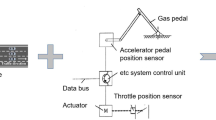Abstract
This study develops a novel continuum model with consideration of the effect of electronic throttle (ET) dynamics to capture the behaviour of vehicles in traffic flow. In particular, the continuum model is proposed by incorporating the opening angle of ET based on the throttle-based full velocity difference model. Theoretical analyses including stability, negative velocity and shock wave are performed systematically. Numerical experiments and comparisons are conducted to verify the performance of the proposed continuum model. Results show that the steady-state performance of the proposed model is improved with respect to the stability. In addition, the proposed model is effective to rapidly dissipate the effect of external perturbation. Also, the phenomenon of negative velocity can be avoided by the proposed model.



Similar content being viewed by others
References
Davoodi, N., Soheili, A.R., Hashemi, S.M.: A macro-model for traffic flow with consideration of driver’s reaction time and distance. Nonlinear Dyn. 83(3), 1621–1628 (2016)
Li, Y.F., Zhang, L., Zheng, H., et al.: Nonlane-discipline-based car-following model for electric vehicles in transportation-cyber-physical systems. IEEE Trans. Intell. Transp. Syst. 19(1), 38–47 (2018)
Gupta, A.K., Katiyar, V.K.: A new multi-class continuum model for traffic flow. Transportmetrica 3(1), 73–85 (2007)
Tang, T.Q., Zhang, J., Liu, K.: A speed guidance model accounting for the driver’s bounded rationality at a signalized intersection. Physica A 473, 45–52 (2017)
Peng, G.H., Sun, D.H.: A dynamical model of car-following with the consideration of the multiple information of preceding cars. Phys. Lett. A 374(15–16), 1694–1698 (2010)
Li, Y.F., Zhang, L., Peeta, S., et al.: Non-lane-discipline-based car-following model considering the effects of two-sided lateral gaps. Nonlinear Dyn. 80(1–2), 227–238 (2015)
Tang, T.Q., Shi, W.F., Shang, H.Y., et al.: A new car-following model with consideration of inter-vehicle communication. Nonlinear Dyn. 76(4), 2017–2023 (2014)
Tang, T.Q., Wang, Y.P., Yang, X.B., et al.: A new car-following model accounting for varying road condition. Nonlinear Dyn. 70(2), 1397–1405 (2012)
Li, Y.F., Zhang, L., Zhang, B., et al.: Non-lane-discipline-based car-following model considering the effect of visual angle. Nonlinear Dyn. 85(3), 1901–1912 (2016)
Ou, H., Tang, T.Q.: An extended two-lane car-following model accounting for inter-vehicle communication. Physica A 495, 260–268 (2018)
Tang, T.Q., Huang, H.J., Shang, H.Y.: Influences of the driver’s bounded rationality on micro driving behavior, fuel consumption and emissions. Transportation Research Part D 41, 423–432 (2015)
Tang, T.Q., Yi, Z.Y., Zhang, J., Zheng, N.: Modeling the driving behavior at a signalized intersection with the information of remaining green time. IET Intelligent Transport Systems 11, 596–603 (2017)
Lighthill, M.J., Whitham, G.B.: On kinematic waves II. A theory of traffic flow on long crowded roads. Proc. R. Soc. Lond. Ser. A 229(1178), 317–345 (1955)
Richards, P.I.: Shock waves on the highway. Oper. Res. 4(1), 42–51 (1956)
Payne, H.J.: Models of freeway traffic and control. In: Bekey, G.A. (ed.) Mathematical Models of Public System. Simulation Councils Proceedings Series, vol. 1, pp. 51-61 (1971)
Daganzo, C.F.: Requiem for second-order fluid approximation of traffic flow. Transp. Res. B 29(4), 277–286 (1995)
Li, Y.F., Song, Y., Yang, B., et al.: A new lattice hydrodynamic model considering the effects of bilateral gaps on vehicular traffic flow. Nonlinear Dyn. 87(1), 1–11 (2017)
Gupta, A.K., Sharma, S., Redhu, P.: Effect of multi-phase optimal velocity function on jamming transition in a lattice hydrodynamic model with passing. Nonlinear Dyn. 80(3), 1091–1108 (2015)
Ge, H.X., Zheng, P.J., Lo, S.M., et al.: TDGL equation in lattice hydrodynamic model considering driver’s physical delay. Nonlinear Dyn. 76(1), 441–445 (2014)
Gupta, A.K., Dhiman, I.: Phase diagram of a continuum traffic flow model with a static bottleneck. Nonlinear Dyn. 79, 663–671 (2015)
Li, Y.F., Zhang, L., Peeta, S., et al.: A car-following model considering the effect of electronic throttle opening angle under connected environment. Nonlinear Dyn. 85(4), 2115–2125 (2016)
Jiang, R., Wu, Q.S., Zhu, Z.J.: A new continuum model for traffic flow and numerical tests. Transp. Res. B 36(5), 405–419 (2002)
Jiang, R., Wu, Q.S., Zhu, Z.J.: Full velocity difference model for a car-following theory. Phys. Rev. E Stat. Nonlinear Soft Matter Phys. 64(1), 017101–017105 (2001)
Tang, T.Q., Huang, H.J., Shang, H.Y.: An extended macro traffic flow model accounting for the driver’s bounded rationality and numerical tests. Physica A 468, 322–333 (2017)
Ou, H., Tang, T.Q.: Impacts of moving bottlenecks on traffic flow. Physica A 500, 131–138 (2018)
Ioannou, P., Xu, Z.: Throttle and brake control system for automatic vehicle following. Intel. Veh. Highw. Syst. J. 1(4), 345–377 (1994)
Pipes, L.A.: Vehicle accelerations in the hydrodynamic theory of traffic flow. Transp. Res. 3(2), 229–234 (1969)
Castillo, J.M.D., Benítez, F.G.: On the functional form of the speed-density relationship—I: general theory. Transp. Res. B 29(5), 373–389 (1995)
Herrmann, M., Kerner, B.S.: Local cluster effect in different traffic flow models. Physica A 255(1–2), 163–188 (1998)
Kerner, B.S., Konhäuser, P.: Cluster effect in initially homogeneous traffic flow. Phys. Rev. E 48(4), R2335–R2338 (1993)
Acknowledgements
This work is jointly supported by the National Natural Science Foundation of China under Grants 61773082 and 71301095, by the Key Project of Basic Science and Emerging Technology of Chongqing under Grant cstc2017jcyjBX0018, by the Key Project of Crossing and Emerging Area of CQUPT under Grant A2018-02, by the Venture & Innovation Support Program for Chongqing Overseas Returnees under Grant CX2017044, and by the National Key Research and Development Program under Grant 2016YFB0100906. The authors make equal contribution to this paper.
Author information
Authors and Affiliations
Corresponding author
Rights and permissions
About this article
Cite this article
Li, Y., Yang, H., Yang, B. et al. An extended continuum model incorporating the electronic throttle dynamics for traffic flow. Nonlinear Dyn 93, 1923–1931 (2018). https://doi.org/10.1007/s11071-018-4298-7
Received:
Accepted:
Published:
Issue Date:
DOI: https://doi.org/10.1007/s11071-018-4298-7




